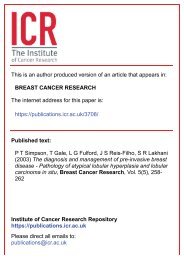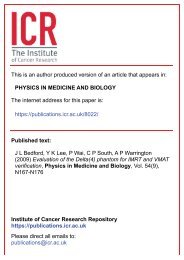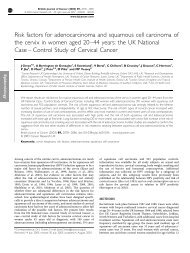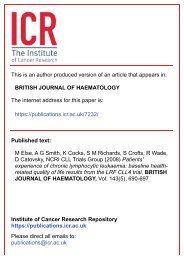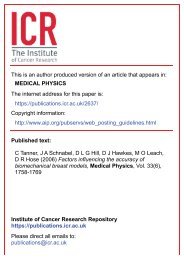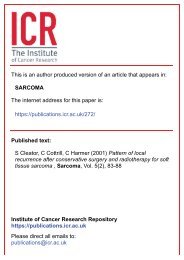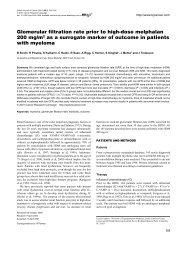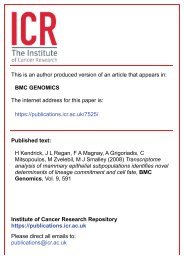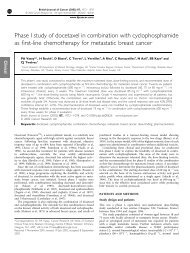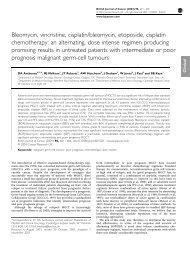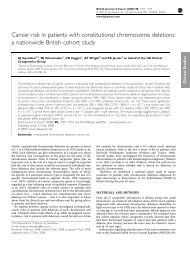First report on the reliability and validity of speech handicap index in ...
First report on the reliability and validity of speech handicap index in ...
First report on the reliability and validity of speech handicap index in ...
- No tags were found...
You also want an ePaper? Increase the reach of your titles
YUMPU automatically turns print PDFs into web optimized ePapers that Google loves.
This is an author produced versi<strong>on</strong> <strong>of</strong> an article that appears <strong>in</strong>:<br />
HEAD AND NECK<br />
The def<strong>in</strong>itive versi<strong>on</strong> is available at:<br />
http://www3.<strong>in</strong>terscience.wiley.com<br />
Published text:<br />
R C Dwivedi, S St Rose, J W Roe, E Chisholm, B Elmiyeh, C<br />
M Nutt<strong>in</strong>g, P M Clarke, C J Kerawala, P H Rhys-Evans, K J<br />
Harr<strong>in</strong>gt<strong>on</strong>, R Kazi (2010) <str<strong>on</strong>g>First</str<strong>on</strong>g> <str<strong>on</strong>g>report</str<strong>on</strong>g> <strong>on</strong> <strong>the</strong> <strong>reliability</strong> <strong>and</strong><br />
<strong>validity</strong> <strong>of</strong> <strong>speech</strong> h<strong>and</strong>icap <strong><strong>in</strong>dex</strong> <strong>in</strong> native English-speak<strong>in</strong>g<br />
patients with head <strong>and</strong> neck cancer, Head <strong>and</strong> Neck<br />
Institute <strong>of</strong> Cancer Research Repository<br />
https://publicati<strong>on</strong>s.icr.ac.uk<br />
Please direct all emails to:<br />
publicati<strong>on</strong>s@icr.ac.uk
<str<strong>on</strong>g>First</str<strong>on</strong>g> <str<strong>on</strong>g>report</str<strong>on</strong>g> <strong>on</strong> <strong>the</strong> Reliability <strong>and</strong> Validity <strong>of</strong> Speech H<strong>and</strong>icap Index (SHI) <strong>in</strong><br />
Native English-speak<strong>in</strong>g Head <strong>and</strong> Neck Cancer Patients<br />
Authors:<br />
Raghav C. Dwivedi, MRCS, DOHNS, MS 1,2 ; Suzanne St. Rose, PhD 1,3 ; Just<strong>in</strong> W.G.<br />
Roe, MSc. Cert. MRCSLT 1,2 ; Edward Chisholm, MRCS, MD 1 ; Behrad Elmiyeh, MRCS,<br />
DOHNS 1 ; Christopher M. Nutt<strong>in</strong>g, FRCR 1,2 ; Peter M. Clarke, FRCS 1 ; Cyrus J. Kerawala,<br />
FRCS, FDSRCS 1,2 ; Peter H. Rhys-Evans, FRCS 1,2 ; Kev<strong>in</strong> J. Harr<strong>in</strong>gt<strong>on</strong>, FRCR, PhD 1,2 ;<br />
Rehan Kazi, MS, FRCS 1,2<br />
Affiliati<strong>on</strong>s:<br />
1<br />
Head <strong>and</strong> Neck Unit, Royal Marsden Hospital, Fulham Road, L<strong>on</strong>d<strong>on</strong>, SW3 6JJ, UK.<br />
2<br />
The Institute <strong>of</strong> Cancer Research, 123 Old Brompt<strong>on</strong> Road, L<strong>on</strong>d<strong>on</strong> SW7 3RP, UK.<br />
3<br />
Department <strong>of</strong> Statistics, Royal Marsden Hospital, Fulham Road, L<strong>on</strong>d<strong>on</strong>, SW3 6JJ, UK<br />
Address for corresp<strong>on</strong>dence:<br />
Dr. Raghav Dwivedi<br />
Head <strong>and</strong> Neck Unit<br />
Royal Marsden Hospital<br />
Fulham Road, L<strong>on</strong>d<strong>on</strong>, SW3 6JJ, UK<br />
Ph: 0044 207 808 2202; E-mail: raghav_dwivedi@rediffmail.com<br />
Fund<strong>in</strong>g <strong>and</strong> f<strong>in</strong>ancial support<br />
Dr. Raghav Dwivedi, Dr. Rehan Kazi <strong>and</strong> Mr. Just<strong>in</strong> Roe are supported by Research<br />
Grants from <strong>the</strong> Head <strong>and</strong> Neck Cancer Research Trust/ The Oracle Cancer Trust.<br />
Acknowledgement:<br />
The authors would like to thank Mr. Rico N. R<strong>in</strong>kel, Department <strong>of</strong> Otolaryngology-<br />
Head <strong>and</strong> Neck Surgery, VU University Medical Center, Amsterdam, The Ne<strong>the</strong>rl<strong>and</strong>s<br />
<strong>and</strong> Pr<strong>of</strong>. Adrian Fourc<strong>in</strong>, Department <strong>of</strong> Ph<strong>on</strong>iatrics <strong>and</strong> L<strong>in</strong>guistics, University College<br />
L<strong>on</strong>d<strong>on</strong>, UK for <strong>the</strong>ir c<strong>on</strong>t<strong>in</strong>uous support <strong>and</strong> encouragement for this study.<br />
Runn<strong>in</strong>g title:<br />
Validati<strong>on</strong> <strong>of</strong> English Versi<strong>on</strong> <strong>of</strong> Speech H<strong>and</strong>icap Index<br />
Key words: Speech H<strong>and</strong>icap Index (SHI); Head <strong>and</strong> neck cancer; Oral cancer;<br />
Oropharyngeal cancer; Quality <strong>of</strong> life.<br />
1
Abstract:<br />
Background<br />
Post-treatment <strong>speech</strong> problems are seen <strong>in</strong> nearly half <strong>of</strong> head <strong>and</strong> neck cancer patients.<br />
Although <strong>the</strong>re are many voice-specific scales, surpris<strong>in</strong>gly <strong>the</strong>re is no <strong>speech</strong>-specific<br />
questi<strong>on</strong>naire for English-speak<strong>in</strong>g head-neck cancer patients. The aim <strong>of</strong> this study was<br />
to validate <strong>the</strong> Speech H<strong>and</strong>icap Index (SHI) as <strong>the</strong> first <strong>speech</strong>-specific questi<strong>on</strong>naire <strong>in</strong><br />
<strong>the</strong> English language.<br />
Method<br />
Fifty-five c<strong>on</strong>secutive patients <strong>in</strong> follow-up for oral <strong>and</strong> oropharyngeal cancer completed<br />
<strong>the</strong> SHI <strong>and</strong> University <strong>of</strong> Wash<strong>in</strong>gt<strong>on</strong> Quality <strong>of</strong> Life Questi<strong>on</strong>naire (UWQOL V.04).<br />
Thirty-two patients completed both questi<strong>on</strong>naires aga<strong>in</strong> four weeks later to address testretest<br />
<strong>reliability</strong>.<br />
Results<br />
Internal c<strong>on</strong>sistency, test-retest <strong>reliability</strong>, c<strong>on</strong>struct <strong>validity</strong> <strong>and</strong> group <strong>validity</strong> <strong>of</strong> <strong>the</strong><br />
SHI were found to be highly significant (P
Introducti<strong>on</strong>:<br />
Head <strong>and</strong> neck cancer per se <strong>and</strong> its treatment may negatively affect patient's functi<strong>on</strong>al<br />
status <strong>and</strong> quality <strong>of</strong> life. 1-6<br />
Patients <strong>of</strong>ten <str<strong>on</strong>g>report</str<strong>on</strong>g> <strong>speech</strong> deteriorati<strong>on</strong>, swallow<strong>in</strong>g<br />
difficulties <strong>and</strong> facial appearance changes which may ultimately result <strong>in</strong> psycho-social<br />
problems. 7-10 Nowhere else is this more obvious than <strong>in</strong> cancers <strong>in</strong>volv<strong>in</strong>g <strong>the</strong> oral cavity<br />
<strong>and</strong> oropharynx. 1,2 The presence <strong>of</strong> post-treatment <strong>speech</strong> problems <strong>in</strong> patients with oral<br />
<strong>and</strong> oropharyngeal cancers has been well documented <strong>in</strong> <strong>the</strong> literature by both<br />
prospective <strong>and</strong> retrospective studies. 11-29 Accord<strong>in</strong>g to recent estimates, nearly 50% <strong>of</strong><br />
oral <strong>and</strong> oropharyngeal cancer patients encounter <strong>speech</strong> problems <strong>in</strong> <strong>the</strong>ir day-to-day<br />
life, 2 which is not surpris<strong>in</strong>g as <strong>the</strong> tumor <strong>and</strong> its treatment <strong>of</strong>ten has a detrimental impact<br />
<strong>on</strong> <strong>the</strong> functi<strong>on</strong><strong>in</strong>g <strong>of</strong> important <strong>speech</strong> articulators (t<strong>on</strong>gue, alveolar ridge, hard <strong>and</strong> s<strong>of</strong>t<br />
palate <strong>and</strong> floor <strong>of</strong> mouth) <strong>in</strong> <strong>the</strong> oral cavity <strong>and</strong> <strong>the</strong> oropharynx. 1 Timely detecti<strong>on</strong> <strong>of</strong><br />
post-treatment <strong>speech</strong> problems <strong>and</strong> <strong>the</strong>ir appropriate rehabilitati<strong>on</strong> is vital <strong>in</strong> provid<strong>in</strong>g a<br />
good functi<strong>on</strong>al QOL to <strong>the</strong>se patients. 1,13<br />
Evaluati<strong>on</strong> <strong>of</strong> patient’s <strong>speech</strong> can be undertaken by ei<strong>the</strong>r subjective methods or<br />
objective <strong>speech</strong> analysis techniques. 1,30 Easiest <strong>and</strong> most comm<strong>on</strong>ly used methods are<br />
subjective <strong>speech</strong> evaluati<strong>on</strong> by us<strong>in</strong>g patient self-rated health-related QOL<br />
questi<strong>on</strong>naires (HRQOL). 1,31 These can be general, disease-specific or<br />
symptom/functi<strong>on</strong>-specific QOL questi<strong>on</strong>naires. 1,31 To date, <strong>the</strong>re are over 1000<br />
<strong>in</strong>struments available for measur<strong>in</strong>g health-related QOL <strong>in</strong> patients. 31 Some comm<strong>on</strong>ly<br />
used head-neck cancer -specific questi<strong>on</strong>naires are University <strong>of</strong> Wash<strong>in</strong>gt<strong>on</strong> QOL<br />
(UWQOL), European Organizati<strong>on</strong> for Research <strong>and</strong> Treatment <strong>of</strong> Cancer head-neck<br />
3
module (EORTC-HN) <strong>and</strong> Functi<strong>on</strong>al Assessment <strong>of</strong> Cancer Therapy head–neck module<br />
(FACT-HN). 1,31 Examples <strong>of</strong> symptom/functi<strong>on</strong>-specific questi<strong>on</strong>naires comm<strong>on</strong>ly used<br />
<strong>in</strong> HNC patients are Performance Status Scale (PSS), MD Anders<strong>on</strong> Dysphagia Inventory<br />
(MDADI) <strong>and</strong> Swallow<strong>in</strong>g Quality <strong>of</strong> Life Questi<strong>on</strong>naire (SWAL-QOL) for swallow<br />
assessment <strong>and</strong> Voice H<strong>and</strong>icap Index (VHI) <strong>and</strong> Voice Related QOL (VRQOL) for<br />
voice assessment. 1,31<br />
Although numerous voice-specific scales exist for use <strong>in</strong> <strong>the</strong><br />
literature, <strong>the</strong>re is no <strong>speech</strong>-specific questi<strong>on</strong>naire available for English-speak<strong>in</strong>g headneck<br />
cancer patients 1 . It is important to dist<strong>in</strong>guish between voice <strong>and</strong> <strong>speech</strong>; voice is a<br />
laryngeal functi<strong>on</strong> while <strong>speech</strong> is <strong>the</strong> f<strong>in</strong>al end-product <strong>of</strong> complex <strong>in</strong>terplay between<br />
vocal tract articulators, hence requires specific assessment tools. 1<br />
The first <strong>speech</strong>specific<br />
questi<strong>on</strong>naire, <strong>the</strong> Speech H<strong>and</strong>icap Index (SHI) was developed <strong>and</strong> validated <strong>in</strong><br />
<strong>the</strong> Dutch language by R<strong>in</strong>kel et al 2 <strong>in</strong> <strong>the</strong> latter half <strong>of</strong> 2008. Our work aims at fill<strong>in</strong>g<br />
this gap by validat<strong>in</strong>g for <strong>the</strong> first time <strong>the</strong> SHI for English-speak<strong>in</strong>g head-neck cancer<br />
patients.<br />
Materials <strong>and</strong> methods:<br />
Patients<br />
Follow<strong>in</strong>g local research ethics committee approval, sixty-three c<strong>on</strong>secutive Englishspeak<strong>in</strong>g<br />
patients <strong>in</strong> follow-up for oral or oropharyngeal cancers at The Royal Marsden<br />
Hospital, L<strong>on</strong>d<strong>on</strong>, UK were recruited for this study. All patients had received curative<br />
treatment <strong>in</strong> <strong>the</strong> form <strong>of</strong> surgery (with or without chemo-radio<strong>the</strong>rapy). Patients with<br />
end-stage disease, o<strong>the</strong>r associated malignancies or any diagnosed neuromuscular disease<br />
known to affect <strong>speech</strong> functi<strong>on</strong> were excluded from <strong>the</strong> study. Tracheostomised patients,<br />
4
patients with<strong>in</strong> <strong>the</strong> first six m<strong>on</strong>ths <strong>of</strong> <strong>in</strong>itial treatment <strong>and</strong> those over 80 years <strong>of</strong> age<br />
were also excluded from <strong>the</strong> study.<br />
Questi<strong>on</strong>naires<br />
The development <strong>of</strong> <strong>the</strong> Dutch versi<strong>on</strong> <strong>of</strong> <strong>the</strong> Speech H<strong>and</strong>icap Index (SHI) was largely<br />
based <strong>on</strong> <strong>the</strong> widely used <strong>and</strong> popular voice-specific scale <strong>the</strong> ‘Voice H<strong>and</strong>icap Index’<br />
(VHI) 32 by R<strong>in</strong>kel et al. 2 C<strong>on</strong>sequently, our English versi<strong>on</strong> <strong>of</strong> SHI (Appendix) is <strong>on</strong> <strong>the</strong><br />
same l<strong>in</strong>es. 32 It has 30 well-c<strong>on</strong>structed questi<strong>on</strong>s to evaluate <strong>the</strong> patient’s <strong>speech</strong> <strong>and</strong><br />
psycho-social functi<strong>on</strong>s. These questi<strong>on</strong>s were adapted from <strong>the</strong> orig<strong>in</strong>al manuscript <strong>of</strong><br />
<strong>the</strong> development <strong>and</strong> validati<strong>on</strong> <strong>of</strong> <strong>the</strong> Dutch versi<strong>on</strong> <strong>of</strong> <strong>the</strong> SHI. Here <strong>the</strong> questi<strong>on</strong>s were<br />
translated <strong>and</strong> <strong>the</strong>n back-translated by expert pr<strong>of</strong>essi<strong>on</strong>al translators to ensure that words<br />
<strong>and</strong> nuances are correctly matched as was c<strong>on</strong>firmed by <strong>the</strong> Dutch group. Our English<br />
versi<strong>on</strong> <strong>of</strong> <strong>the</strong> SHI is based <strong>on</strong> a Likert five- po<strong>in</strong>t scale with resp<strong>on</strong>se categories as never<br />
(0); almost never (1); sometimes (2); almost always (3) <strong>and</strong> always (4). Total SHI score is<br />
calculated by add<strong>in</strong>g all <strong>the</strong> resp<strong>on</strong>se numbers <strong>and</strong> can range from 0-120; higher scores<br />
<strong>in</strong>dicate more severe <strong>speech</strong>-related problems. In additi<strong>on</strong> to <strong>the</strong>se 30 questi<strong>on</strong>s, <strong>the</strong>re is a<br />
global questi<strong>on</strong> which rates <strong>the</strong> patient’s overall <strong>speech</strong> quality. Here <strong>the</strong>re are four<br />
resp<strong>on</strong>se categories: excellent; good; average <strong>and</strong> bad which are scored as 0, 30, 70 <strong>and</strong><br />
100. Higher scores aga<strong>in</strong> <strong>in</strong>dicate a greater <strong>speech</strong> problem.<br />
For <strong>the</strong> purpose <strong>of</strong> <strong>validity</strong>, we have utilized <strong>the</strong> UWQOL V.04 as a comparative QOL<br />
scale. This is a validated, widely-used, self-adm<strong>in</strong>istered head <strong>and</strong> neck cancer-specific<br />
questi<strong>on</strong>naire with 12 doma<strong>in</strong>s for evaluati<strong>on</strong>, <strong>speech</strong> be<strong>in</strong>g <strong>on</strong>e <strong>of</strong> <strong>the</strong>m. O<strong>the</strong>r doma<strong>in</strong>s<br />
<strong>in</strong>cluded are pa<strong>in</strong>, appearance, activity, recreati<strong>on</strong>, swallow<strong>in</strong>g, chew<strong>in</strong>g, shoulder<br />
5
functi<strong>on</strong>, taste, saliva, mood <strong>and</strong> anxiety. 33,34 Here <strong>speech</strong> is evaluated by a s<strong>in</strong>gle<br />
questi<strong>on</strong> based <strong>on</strong> a Guttman four- po<strong>in</strong>t scale <strong>and</strong> scored as 0, 30, 70 <strong>and</strong> 100. Higher<br />
scores <strong>in</strong>dicate better <strong>speech</strong> functi<strong>on</strong>. UWQOL social functi<strong>on</strong> score is computed as <strong>the</strong><br />
simple average <strong>of</strong> 6 doma<strong>in</strong>s (anxiety, mood, pa<strong>in</strong>, activity, recreati<strong>on</strong> <strong>and</strong> shoulder<br />
functi<strong>on</strong>).<br />
Adm<strong>in</strong>istrati<strong>on</strong> <strong>of</strong> questi<strong>on</strong>naire<br />
Patients were given <strong>the</strong> SHI <strong>and</strong> UWQOL questi<strong>on</strong>naires <strong>in</strong> <strong>the</strong> outpatient cl<strong>in</strong>ic with a<br />
pers<strong>on</strong>alized cover<strong>in</strong>g letter expla<strong>in</strong><strong>in</strong>g briefly <strong>the</strong> purpose <strong>of</strong> <strong>the</strong> study. In additi<strong>on</strong>, <strong>the</strong><br />
questi<strong>on</strong>naires <strong>and</strong> <strong>the</strong> purpose <strong>of</strong> study were also expla<strong>in</strong>ed (face-to-face) to each<br />
patient. The patients were requested to complete both scales with<strong>in</strong> 24 hours <strong>of</strong> each<br />
o<strong>the</strong>r <strong>and</strong> return <strong>the</strong> questi<strong>on</strong>naires via post. A r<strong>and</strong>omly selected subset <strong>of</strong> thirty-two<br />
patients was asked to complete both <strong>the</strong> questi<strong>on</strong>naires (SHI & UWQOL) aga<strong>in</strong> after four<br />
weeks <strong>in</strong> order to assess test-retest <strong>reliability</strong>.<br />
Statistical analysis<br />
Demographic <strong>and</strong> treatment details <strong>of</strong> all patients were extracted from <strong>the</strong> medical<br />
records <strong>and</strong> <strong>the</strong> data were entered <strong>in</strong> to a worksheet (Excel 05; Micros<strong>of</strong>t Corp., WA,<br />
USA). Questi<strong>on</strong>naire data were also entered <strong>in</strong> <strong>the</strong> worksheet for <strong>the</strong> purpose <strong>of</strong> analysis.<br />
Analysis was performed us<strong>in</strong>g <strong>the</strong> commercially available Statistical Package for Social<br />
Sciences-15 statistical s<strong>of</strong>tware (SPSS Inc., Chicago, IL, USA). Questi<strong>on</strong>naire data were<br />
<strong>the</strong>n subjected to <strong>reliability</strong> <strong>and</strong> <strong>validity</strong> assessment.<br />
6
Reliability<br />
Both <strong>the</strong> <strong>in</strong>ternal c<strong>on</strong>sistency <strong>and</strong> test-retest <strong>reliability</strong> were measured <strong>in</strong> this study.<br />
Internal c<strong>on</strong>sistency <strong>and</strong> test-retest <strong>reliability</strong> were determ<strong>in</strong>ed us<strong>in</strong>g Cr<strong>on</strong>bach’s alpha<br />
coefficient <strong>and</strong> Spearman’s rank correlati<strong>on</strong> coefficient, respectively. A high Cr<strong>on</strong>bach’s<br />
alpha (>0.70) <strong>and</strong> Spearman’s correlati<strong>on</strong> (rho > 0.60) value <strong>in</strong>dicates adequate <strong>in</strong>ternal<br />
c<strong>on</strong>sistency <strong>and</strong> test-retest <strong>reliability</strong>. 35<br />
Validity<br />
C<strong>on</strong>struct <strong>and</strong> group <strong>validity</strong> were assessed by correlat<strong>in</strong>g <strong>speech</strong> item score with related<br />
c<strong>on</strong>structs from <strong>the</strong> UWQOL questi<strong>on</strong>naire. ‘Bench marks’ for evaluat<strong>in</strong>g correlati<strong>on</strong><br />
values are >0.60: str<strong>on</strong>g correlati<strong>on</strong>; 0.40 to 0.60: moderate to substantial correlati<strong>on</strong>;<br />
<strong>of</strong> 87%. The median age <strong>of</strong> <strong>the</strong> group was 59.4 years (range: 35.9-80.0) with 36 males<br />
<strong>and</strong> 19 females. Detailed patient characteristics are provided <strong>in</strong> Table 1. Briefly, 17<br />
(30.9%) patients had cancer <strong>of</strong> <strong>the</strong> oral cavity while 38 (69.1) patients had oropharyngeal<br />
cancer.<br />
Reliability<br />
Internal c<strong>on</strong>sistency<br />
The <strong>in</strong>ternal c<strong>on</strong>sistency <strong>reliability</strong> for Total SHI (mean <strong>of</strong> all 30 questi<strong>on</strong>s) <strong>and</strong> SHI<br />
<strong>speech</strong> doma<strong>in</strong> (mean <strong>of</strong> 14 questi<strong>on</strong>s specific for evaluati<strong>on</strong> <strong>of</strong> <strong>speech</strong> functi<strong>on</strong>s) as<br />
calculated by Cr<strong>on</strong>bach’s alpha coefficient was 0.98 <strong>and</strong> 0.95, respectively. For SHI<br />
psycho-social doma<strong>in</strong> (mean <strong>of</strong> 14 questi<strong>on</strong>s specific for evaluati<strong>on</strong> <strong>of</strong> psycho-social<br />
functi<strong>on</strong>) Cr<strong>on</strong>bach’s alpha coefficient was 0.98. (Table 2)<br />
Test-retest <strong>reliability</strong><br />
Test-retest <strong>reliability</strong> <strong>of</strong> Total SHI <strong>and</strong> SHI <strong>speech</strong> doma<strong>in</strong> as calculated by Spearman’s<br />
rank correlati<strong>on</strong> coefficient were 0.92 <strong>and</strong> 0.88, respectively. For SHI psycho-social<br />
doma<strong>in</strong> <strong>the</strong> coefficient was 0.89. (Table 3). Test-retest <strong>reliability</strong> <strong>of</strong> additi<strong>on</strong>al SHI<br />
questi<strong>on</strong> assess<strong>in</strong>g overall <strong>speech</strong> quality was 0.78.<br />
Validity<br />
C<strong>on</strong>struct <strong>validity</strong><br />
To assess c<strong>on</strong>vergent c<strong>on</strong>struct <strong>validity</strong> <strong>and</strong> to determ<strong>in</strong>e <strong>the</strong> extent to which hypo<strong>the</strong>tical<br />
relati<strong>on</strong>ships are c<strong>on</strong>firmed 35 , we compared Total SHI values <strong>and</strong> values <strong>of</strong> <strong>speech</strong> <strong>and</strong><br />
8
psychosocial doma<strong>in</strong>s <strong>of</strong> SHI with <strong>speech</strong> <strong>and</strong> social assessment doma<strong>in</strong>s <strong>of</strong> <strong>the</strong> UWQOL<br />
questi<strong>on</strong>naire us<strong>in</strong>g Spearman’s rank correlati<strong>on</strong> coefficients. The correlati<strong>on</strong> between<br />
Total SHI score, <strong>the</strong> SHI <strong>speech</strong> doma<strong>in</strong>, <strong>the</strong> SHI psycho-social doma<strong>in</strong> <strong>and</strong> overall SHI<br />
<strong>speech</strong> assessment questi<strong>on</strong>, <strong>and</strong> <strong>speech</strong> doma<strong>in</strong> <strong>of</strong> UWQOL were 0.72, 0.72, 0.71 <strong>and</strong><br />
0.68, respectively (Table 4).<br />
The correlati<strong>on</strong>s between Total SHI score, <strong>the</strong> SHI <strong>speech</strong> doma<strong>in</strong>, <strong>the</strong> SHI psycho-social<br />
doma<strong>in</strong> <strong>and</strong> overall SHI <strong>speech</strong> assessment questi<strong>on</strong>, <strong>and</strong> social doma<strong>in</strong> <strong>of</strong> <strong>the</strong> UWQOL<br />
were 0.44, 0.44, 0.43 <strong>and</strong> 0.35, respectively (Table 4).<br />
Group <strong>validity</strong><br />
To determ<strong>in</strong>e <strong>the</strong> ability <strong>of</strong> <strong>the</strong> SHI to detect differences <strong>in</strong> groups <strong>of</strong> patients who were<br />
expected to be functi<strong>on</strong><strong>in</strong>g at different levels, we performed a group <strong>validity</strong> test us<strong>in</strong>g<br />
Mann-Whitney U-test. Significant differences (P
imparted by <strong>the</strong> articulators <strong>in</strong> <strong>the</strong> vocal tract. 1 Therefore use <strong>of</strong> voice evaluati<strong>on</strong> tools for<br />
evaluat<strong>in</strong>g <strong>speech</strong> outcome is not scientifically justified as <strong>the</strong> results will not represent or<br />
reflect what is <strong>in</strong>tended to be measured. 1 Also <strong>the</strong> use <strong>of</strong> general or disease-specific QOL<br />
questi<strong>on</strong>naires for evaluat<strong>in</strong>g <strong>speech</strong> outcomes <strong>in</strong> head-neck cancer patients is not<br />
advisable as <strong>the</strong>y are not sensitive enough utiliz<strong>in</strong>g <strong>on</strong>ly <strong>on</strong>e or two questi<strong>on</strong>s to assess<br />
<strong>speech</strong>. 1<br />
Reliability refers to <strong>the</strong> extent to which a test score is free from errors <strong>of</strong> measurement. 35-<br />
37 The importance <strong>of</strong> rigorously establish<strong>in</strong>g <strong>reliability</strong> translates <strong>in</strong>to accurate detecti<strong>on</strong><br />
<strong>of</strong> change as a result <strong>of</strong> change <strong>in</strong> cl<strong>in</strong>ical status. The two most comm<strong>on</strong>ly used measures<br />
<strong>of</strong> <strong>reliability</strong> are <strong>in</strong>ternal c<strong>on</strong>sistency <strong>and</strong> test-retest <strong>reliability</strong>. 37,38 Internal c<strong>on</strong>sistency is<br />
useful <strong>in</strong> <strong>the</strong> c<strong>on</strong>structi<strong>on</strong> <strong>of</strong> new scales or questi<strong>on</strong>naires <strong>and</strong> measures <strong>the</strong> <strong>in</strong>c<strong>on</strong>sistency<br />
or n<strong>on</strong>-equivalence <strong>of</strong> different questi<strong>on</strong>s <strong>in</strong>tended to measure <strong>the</strong> same c<strong>on</strong>cept. 35 We<br />
have used alpha <strong>reliability</strong> which is similar to <strong>the</strong> split-half approach to measure<br />
c<strong>on</strong>sistency except that all possible ways <strong>of</strong> splitt<strong>in</strong>g <strong>and</strong> compar<strong>in</strong>g sets <strong>of</strong> questi<strong>on</strong>s<br />
used to tap a particular c<strong>on</strong>cept are performed. 37-40 Cr<strong>on</strong>bach’s alpha is <strong>the</strong> measure <strong>of</strong> <strong>the</strong><br />
alpha coefficient. 36,41,42 The value, which can vary from 0.0 to 1.0, represents how well a<br />
set <strong>of</strong> items measures <strong>the</strong> same underly<strong>in</strong>g dimensi<strong>on</strong>. 35 Cr<strong>on</strong>bach’s alpha values that are<br />
between 0.70 <strong>and</strong> 0.90 suggest that <strong>the</strong> scale has adequate <strong>in</strong>ternal c<strong>on</strong>sistency. 36 We<br />
found SHI to have a high Cr<strong>on</strong>bach’s alpha coefficients for Total SHI, SHI <strong>speech</strong><br />
doma<strong>in</strong> <strong>and</strong> SHI psycho-social doma<strong>in</strong>s which is <strong>in</strong>dicative that <strong>the</strong> questi<strong>on</strong>naire was<br />
c<strong>on</strong>sistent <strong>and</strong> addressed <strong>the</strong> same c<strong>on</strong>cept reliably. It is assumed that a measure with<br />
limited <strong>reliability</strong> will not provide a stable score across time. Test-retest <strong>reliability</strong> is a<br />
10
measure to estimate that <strong>the</strong> c<strong>on</strong>struct or dimensi<strong>on</strong> be<strong>in</strong>g assessed is stable over time.<br />
The values <strong>of</strong> Total SHI scores, SHI <strong>speech</strong> doma<strong>in</strong>, SHI psycho-social doma<strong>in</strong> <strong>and</strong><br />
overall <strong>speech</strong> quality were found to be highly significant by us<strong>in</strong>g Spearman’s rank<br />
correlati<strong>on</strong> coefficient.<br />
Validity is <strong>of</strong>ten seen as <strong>the</strong> most important c<strong>on</strong>siderati<strong>on</strong> <strong>in</strong> evaluati<strong>on</strong> <strong>of</strong> a measure. 37,38<br />
However, it must be remembered here that <strong>validity</strong> does not refer to any <strong>in</strong>herent<br />
characteristic <strong>of</strong> <strong>the</strong> measure; measures <strong>the</strong>mselves are never valid or <strong>in</strong>valid. 37 Although<br />
several types <strong>of</strong> <strong>validity</strong> have been described <strong>in</strong> <strong>the</strong> literature, <strong>the</strong> most comm<strong>on</strong> <strong>and</strong><br />
important types are c<strong>on</strong>struct <strong>validity</strong>, group <strong>validity</strong>, c<strong>on</strong>tent <strong>validity</strong> <strong>and</strong> criteri<strong>on</strong><br />
<strong>validity</strong>. 35 C<strong>on</strong>struct <strong>validity</strong> refers to <strong>the</strong> extent to which a measure assesses <strong>the</strong> specific<br />
doma<strong>in</strong> or c<strong>on</strong>struct <strong>of</strong> <strong>in</strong>terest. 35 A widely used method <strong>of</strong> assess<strong>in</strong>g c<strong>on</strong>struct <strong>validity</strong> is<br />
to exam<strong>in</strong>e how hypo<strong>the</strong>tical relati<strong>on</strong>ships are c<strong>on</strong>firmed. Therefore, <strong>the</strong> more <strong>of</strong>ten <strong>the</strong><br />
hypo<strong>the</strong>tical relati<strong>on</strong>ships are c<strong>on</strong>firmed, <strong>the</strong> greater <strong>the</strong> c<strong>on</strong>struct <strong>validity</strong> <strong>of</strong> <strong>the</strong> survey<br />
variables is assumed to be. 41,42 Different doma<strong>in</strong>s <strong>of</strong> SHI were compared with similar<br />
doma<strong>in</strong>s <strong>of</strong> <strong>the</strong> exist<strong>in</strong>g st<strong>and</strong>ard, validated UWQOL questi<strong>on</strong>naire with <strong>the</strong> help <strong>of</strong><br />
Spearman’s rank correlati<strong>on</strong> coefficient. Total SHI score, <strong>the</strong> SHI <strong>speech</strong> doma<strong>in</strong>, <strong>the</strong><br />
SHI psycho-social doma<strong>in</strong> <strong>and</strong> overall SHI <strong>speech</strong> assessment questi<strong>on</strong> <strong>and</strong> <strong>speech</strong><br />
doma<strong>in</strong> <strong>of</strong> UWQOL were found to be highly significant. The correlati<strong>on</strong>s between Total<br />
SHI score, <strong>the</strong> SHI <strong>speech</strong> doma<strong>in</strong>, <strong>the</strong> SHI psycho-social doma<strong>in</strong> <strong>and</strong> overall SHI <strong>speech</strong><br />
assessment questi<strong>on</strong> <strong>and</strong> social doma<strong>in</strong> <strong>of</strong> UWQOL showed moderate correlati<strong>on</strong>. The<br />
relatively low values <strong>of</strong> SHI psycho-social doma<strong>in</strong> when compared with social doma<strong>in</strong> <strong>of</strong><br />
UWQOL may be because <strong>of</strong> <strong>in</strong>corporati<strong>on</strong> <strong>of</strong> two grossly different sub-doma<strong>in</strong>s (pa<strong>in</strong><br />
11
<strong>and</strong> shoulder functi<strong>on</strong>s) to calculate social doma<strong>in</strong> scores <strong>of</strong> UWQOL. Group <strong>validity</strong><br />
refers to <strong>the</strong> ability <strong>of</strong> <strong>the</strong> questi<strong>on</strong>naire or tool to be able to detect differences <strong>in</strong> groups<br />
<strong>of</strong> patients who were expected to be functi<strong>on</strong><strong>in</strong>g at different levels. 36 The SHI was able to<br />
differentiate between groups <strong>of</strong> patients assumed to have different magnitudes <strong>of</strong> <strong>speech</strong><br />
impairment. Some values <strong>in</strong> group analysis were found to be <strong>in</strong>significant, probably<br />
because <strong>of</strong> smaller sample size or differences <strong>in</strong> patient characteristics, detailed analysis<br />
<strong>of</strong> which is currently <strong>on</strong>go<strong>in</strong>g <strong>in</strong> <strong>the</strong> department. C<strong>on</strong>tent <strong>validity</strong> or face <strong>validity</strong><br />
precisely refers to how well <strong>the</strong> questi<strong>on</strong>s represent what is try<strong>in</strong>g to be asked from <strong>the</strong><br />
<strong>the</strong>oretical framework. 37-39 It is most <strong>of</strong>ten determ<strong>in</strong>ed by <strong>the</strong> use <strong>of</strong> expert judgments <strong>and</strong><br />
is an <strong>in</strong>tegral part <strong>of</strong> develop<strong>in</strong>g any psychometric tool. 35<br />
Though we did not develop <strong>the</strong><br />
questi<strong>on</strong>naire, but still as a part <strong>of</strong> c<strong>on</strong>sensus process, every s<strong>in</strong>gle questi<strong>on</strong> was<br />
discussed <strong>and</strong> debated <strong>in</strong> multidiscipl<strong>in</strong>ary team sett<strong>in</strong>g compris<strong>in</strong>g experienced head <strong>and</strong><br />
neck cancer specialists, <strong>speech</strong> <strong>and</strong> language <strong>the</strong>rapists with over 10 years <strong>of</strong> experience<br />
<strong>in</strong> manag<strong>in</strong>g head <strong>and</strong> neck cancer patients <strong>and</strong> most importantly patients as well. No<br />
items <strong>of</strong> <strong>the</strong> questi<strong>on</strong>naire were flagged by <strong>the</strong> subjects <strong>and</strong> experts as <strong>in</strong>appropriate or<br />
unclear. Criteri<strong>on</strong> or c<strong>on</strong>current <strong>validity</strong> serves to establish whe<strong>the</strong>r <strong>the</strong> new survey<br />
<strong>in</strong>strument accurately reflects <strong>the</strong> attitudes <strong>of</strong> a previously used gold-st<strong>and</strong>ard measure <strong>of</strong><br />
<strong>the</strong> same c<strong>on</strong>cept. S<strong>in</strong>ce <strong>the</strong>re is no o<strong>the</strong>r <strong>speech</strong>-specific questi<strong>on</strong>naire <strong>in</strong> <strong>the</strong> literature<br />
with which SHI can be compared, criteri<strong>on</strong> <strong>validity</strong> was not assessable.<br />
The English language versi<strong>on</strong> <strong>of</strong> SHI has shown high values <strong>of</strong> <strong>reliability</strong> <strong>and</strong> <strong>validity</strong><br />
scores which are parallel to <strong>the</strong> Dutch versi<strong>on</strong>, 2 <strong>in</strong>dicat<strong>in</strong>g it to be a good tool for<br />
evaluat<strong>in</strong>g <strong>the</strong> impact <strong>of</strong> <strong>speech</strong> impairment <strong>in</strong> head-neck cancer patients. Patients can<br />
12
easily complete it while wait<strong>in</strong>g for <strong>the</strong>ir turn to come <strong>in</strong> <strong>the</strong> outpatient department. The<br />
results can be quickly calculated <strong>and</strong> documented <strong>in</strong> <strong>the</strong> patient records <strong>and</strong> if any <strong>speech</strong><br />
impairment is found, it can be addressed - possibly at <strong>the</strong> same visit. Patients can also be<br />
given feedback <strong>on</strong> <strong>the</strong>ir <strong>speech</strong> rehabilitative efforts <strong>in</strong> a temporal manner which will<br />
help <strong>the</strong>m to <strong>in</strong>tensify, c<strong>on</strong>t<strong>in</strong>ue or decrease <strong>the</strong>ir efforts <strong>in</strong> order to get better <strong>speech</strong>. We<br />
th<strong>in</strong>k this tool will be an effective adjunct <strong>in</strong> <strong>the</strong> rehabilitati<strong>on</strong> <strong>of</strong> head-neck cancer<br />
patients.<br />
C<strong>on</strong>clusi<strong>on</strong>:<br />
In this study <strong>the</strong> SHI proved to be a valid <strong>and</strong> reliable tool for outcome assessment <strong>of</strong><br />
<strong>speech</strong> problems <strong>in</strong> oral <strong>and</strong> oropharyngeal cancer patients. It is a precise, reliable <strong>and</strong><br />
validated <strong>speech</strong> questi<strong>on</strong>naire which can be used <strong>in</strong> outpatient cl<strong>in</strong>ics to assess <strong>the</strong> nature<br />
<strong>and</strong> severity <strong>of</strong> a patient’s compla<strong>in</strong>ts. S<strong>in</strong>ce it is a new tool, fur<strong>the</strong>r studies are required<br />
to establish its usefulness <strong>in</strong> assess<strong>in</strong>g <strong>speech</strong> impairment <strong>in</strong> head-neck cancer patients.<br />
C<strong>on</strong>flict <strong>of</strong> <strong>in</strong>terest<br />
N<strong>on</strong>e to declare.<br />
Appendix:<br />
Speech H<strong>and</strong>icap Index (SHI) English versi<strong>on</strong> (for cl<strong>in</strong>ical research <strong>and</strong> patient use).<br />
13
References:<br />
1. Dwivedi RC, Kazi RA, Agrawal N, et al. Evaluati<strong>on</strong> <strong>of</strong> <strong>speech</strong> outcomes<br />
follow<strong>in</strong>g treatment <strong>of</strong> oral <strong>and</strong> oropharyngeal cancers. Cancer Treat Rev.<br />
2009;35(5):417-24.<br />
2. R<strong>in</strong>kel RN, Leeuw IM, van Reij EJ, Aar<strong>on</strong>s<strong>on</strong> NK, Leemans CR. Speech<br />
h<strong>and</strong>icap <strong><strong>in</strong>dex</strong> <strong>in</strong> patients with oral <strong>and</strong> pharyngeal cancer: better underst<strong>and</strong><strong>in</strong>g<br />
<strong>of</strong> patients’ compla<strong>in</strong>ts. Head Neck 2008;30(7):868–74.<br />
3. Karnell LH, Funk GF, H<strong>of</strong>fman HT. Assess<strong>in</strong>g head <strong>and</strong> neck cancer patient<br />
outcome doma<strong>in</strong>s. Head Neck. 2000;22(1):6-11<br />
4. Borggreven PA, Verd<strong>on</strong>ck-de Leeuw I, Langendijk JA, et al. Speech outcome<br />
after surgical treatment for oral <strong>and</strong> oropharyngeal cancer: a l<strong>on</strong>gitud<strong>in</strong>al<br />
assessment <strong>of</strong> patients rec<strong>on</strong>structed by a microvascular flap. Head Neck<br />
2005;27(9):785–93.<br />
5. Zuydam AC, Lowe D, Brown JS, Vaughan ED, Rogers SN. Predictors <strong>of</strong> <strong>speech</strong><br />
<strong>and</strong> swallow<strong>in</strong>g functi<strong>on</strong> follow<strong>in</strong>g primary surgery for oral <strong>and</strong> oropharyngeal<br />
cancer. Cl<strong>in</strong> Otolaryngol 2005;30(5):428–37.<br />
6. Perry AR, Shaw MA, Cott<strong>on</strong> S. An evaluati<strong>on</strong> <strong>of</strong> functi<strong>on</strong>al outcomes (<strong>speech</strong>,<br />
swallow<strong>in</strong>g) <strong>in</strong> patients attend<strong>in</strong>g <strong>speech</strong> pathology after head <strong>and</strong> neck cancer<br />
treatment(s): results <strong>and</strong> analysis at 12 m<strong>on</strong>ths post-<strong>in</strong>terventi<strong>on</strong>. J Laryngol Otol<br />
2003;117(5):368–81.<br />
7. Ackerstaff AH, L<strong>in</strong>deboom JA, Balm AJ, Kro<strong>on</strong> FH, Tan IB, Hilgers FJ.<br />
Structured assessment <strong>of</strong> <strong>the</strong> c<strong>on</strong>sequences <strong>of</strong> composite resecti<strong>on</strong>. Cl<strong>in</strong><br />
Otolaryngol 1998; 23: 339-344.<br />
14
8. De Boer MF, Pruyn JF, van den Borne B, Knegt PP, Ryckman RM, Verwoerd<br />
CD. Rehabilitati<strong>on</strong> outcomes <strong>of</strong> l<strong>on</strong>g-term survivors treated for head <strong>and</strong> neck<br />
cancer. Head Neck 1995; 17: 503-515.<br />
9. De Boer MF, McCormick LK, Pruyn JF, Rijckman RM, van den Borne BW.<br />
Physical <strong>and</strong> psychosocial correlates <strong>of</strong> head <strong>and</strong> neck cancer: a review <strong>of</strong> <strong>the</strong><br />
literature. Otolaryngol Head Neck Surg 1999; 120: 427-436.<br />
10. Hammerlid E, Ahlner-Elmqvist M, Bjordal K, et al. A prospective multicentre<br />
study <strong>in</strong> Sweden <strong>and</strong> Norway <strong>of</strong> mental distress <strong>and</strong> psychiatric morbidity <strong>in</strong> head<br />
<strong>and</strong> neck cancer patients. Br J Cancer 1999; 80: 766-774.<br />
11. Logemann JA, Pauloski BR, Rademaker AW, Colangelo LA. Speech <strong>and</strong><br />
swallow<strong>in</strong>g rehabilitati<strong>on</strong> for head <strong>and</strong> neck cancer patients. Oncology (Hunt<strong>in</strong>gt)<br />
1997; 11: 651-656.<br />
12. Seikaly H, Rieger J, Wolfaardt J, Moysa G, Harris J, Jha N. Functi<strong>on</strong>al outcomes<br />
after primary oropharyngeal cancer resecti<strong>on</strong> <strong>and</strong> rec<strong>on</strong>structi<strong>on</strong> with <strong>the</strong> radial<br />
forearm free flap. Laryngoscope 2003;113(5):897–904.<br />
13. Furia CL, Kowalski LP, Latorre MR, et al. Speech <strong>in</strong>telligibility after<br />
glossectomy <strong>and</strong> <strong>speech</strong> rehabilitati<strong>on</strong>. Arch Otolaryngol Head Neck Surg<br />
2001;127(7):877–83.<br />
14. Borggreven PA, Verd<strong>on</strong>ck-de Leeuw IM, Muller MJ, et al. Quality <strong>of</strong> life <strong>and</strong><br />
functi<strong>on</strong>al status <strong>in</strong> patients with cancer <strong>of</strong> <strong>the</strong> oral cavity <strong>and</strong> oropharynx:<br />
pretreatment values <strong>of</strong> a prospective study. Eur Arch Otorh<strong>in</strong>olaryngol<br />
2007;264(6):651–7.<br />
15
15. Colangelo LA, Logemann JA, Rademaker AW. Tumor size <strong>and</strong> pretreatment<br />
<strong>speech</strong> <strong>and</strong> swallow<strong>in</strong>g <strong>in</strong> patients with resectable tumors. Otolaryngol Head<br />
Neck Surg 2000;122(5):653–61.<br />
16. Hahn TR, Krüskemper G. The impact <strong>of</strong> radio<strong>the</strong>rapy <strong>on</strong> quality <strong>of</strong> life – a survey<br />
<strong>of</strong> 1411 patients with oral cancer. Mund Kiefer Gesichtschir 2007;11(2):99–106<br />
17. Mort<strong>on</strong> RP. Studies <strong>in</strong> <strong>the</strong> quality <strong>of</strong> life <strong>of</strong> head <strong>and</strong> neck cancer patients: results<br />
<strong>of</strong> a two-year l<strong>on</strong>gitud<strong>in</strong>al study <strong>and</strong> a comparative cross-secti<strong>on</strong>al cross-cultural<br />
survey. Laryngoscope 2003;113(7):1091–103.<br />
18. Nicoletti G, Soutar DS, Jacks<strong>on</strong> MS, Wrench AA, Roberts<strong>on</strong> G. Chew<strong>in</strong>g <strong>and</strong><br />
swallow<strong>in</strong>g after surgical treatment for oral cancer: functi<strong>on</strong>al evaluati<strong>on</strong> <strong>in</strong> 196<br />
selected cases. Plast Rec<strong>on</strong>str Surg 2004;114(2):329–38.<br />
19. Nijdam WM, Levendag PC, Noever I, Schmitz PI, Uyl-de Groot CA.<br />
L<strong>on</strong>gitud<strong>in</strong>al changes <strong>in</strong> quality <strong>of</strong> life <strong>and</strong> costs <strong>in</strong> l<strong>on</strong>g-term survivors <strong>of</strong> tumors<br />
<strong>of</strong> <strong>the</strong> oropharynx treated with brachy<strong>the</strong>rapy or surgery. Brachy<strong>the</strong>rapy<br />
2008;7(4):343–50.<br />
20. Rieger J, Dicks<strong>on</strong> N, Lemire R, et al. Social percepti<strong>on</strong> <strong>of</strong> <strong>speech</strong> <strong>in</strong> <strong>in</strong>dividuals<br />
with oropharyngeal rec<strong>on</strong>structi<strong>on</strong>. J Psychosoc Oncol 2006;24(4):33–51.<br />
21. Rieger JM, Zalmanowitz JG, Li SY, et al. Functi<strong>on</strong>al outcomes after surgical<br />
rec<strong>on</strong>structi<strong>on</strong> <strong>of</strong> <strong>the</strong> base <strong>of</strong> t<strong>on</strong>gue us<strong>in</strong>g <strong>the</strong> radial forearm free flap <strong>in</strong> patients<br />
with oropharyngeal carc<strong>in</strong>oma. Head Neck 2007;29(11):1024–32.<br />
22. Rogers SN, Lowe D, Fisher SE, Brown JS, Vaughan ED. Health-related quality <strong>of</strong><br />
life <strong>and</strong> cl<strong>in</strong>ical functi<strong>on</strong> after primary surgery for oral cancer. Br J Oral<br />
Maxill<strong>of</strong>ac Surg 2002;40(1):11–8.<br />
16
23. Seikaly H, Rieger J, O’C<strong>on</strong>nell D, Ansari K, Alqahtani K, Harris J. Beavertail<br />
modificati<strong>on</strong> <strong>of</strong> <strong>the</strong> radial forearm free flap <strong>in</strong> base <strong>of</strong> t<strong>on</strong>gue rec<strong>on</strong>structi<strong>on</strong>:<br />
technique <strong>and</strong> functi<strong>on</strong>al outcomes. Head Neck. 2009;31(2):213-9.<br />
24. Suarez-Cunqueiro MM, Schramm A, Schoen R, et al. Speech <strong>and</strong> swallow<strong>in</strong>g<br />
impairment after treatment for oral <strong>and</strong> oropharyngeal cancer. Arch Otolaryngol<br />
Head Neck Surg 2008;134(12):1299–304.<br />
25. Vartanian JG, Carvalho AL, Yueh B, Priante AV, et al. L<strong>on</strong>g-term quality-<strong>of</strong>-life<br />
evaluati<strong>on</strong> after head <strong>and</strong> neck cancer treatment <strong>in</strong> a develop<strong>in</strong>g country. Arch<br />
Otolaryngol Head Neck Surg 2004;130(10):1209–13.<br />
26. Villaret AB, Cappiello J, Piazza C, Pedruzzi B, Nicolai P. Quality <strong>of</strong> life <strong>in</strong><br />
patients treated for cancer <strong>of</strong> <strong>the</strong> oral cavity requir<strong>in</strong>g rec<strong>on</strong>structi<strong>on</strong>: a<br />
prospective study. Acta Otorh<strong>in</strong>olaryngol Ital 2008;28(3):120–5.<br />
27. Bozec A, Poiss<strong>on</strong>net G, Chamorey E, et al. Free-flap head <strong>and</strong> neck<br />
rec<strong>on</strong>structi<strong>on</strong> <strong>and</strong> quality <strong>of</strong> life: a 2-year prospective study. Laryngoscope<br />
2008;118(5):874–80.<br />
28. Mal<strong>on</strong>e JP, Stephens JA, Grecula JC, Rhoades CA, Ghaheri BA, Schuller DE.<br />
Disease c<strong>on</strong>trol, survival, <strong>and</strong> functi<strong>on</strong>al outcome after multimodal treatment for<br />
advanced-stage t<strong>on</strong>gue base cancer. Head Neck 2004;26(7):561–72.<br />
29. Pourel N, Peiffert D, Lartigau E, Des<strong>and</strong>es E, Luporsi E, C<strong>on</strong>roy T. Quality <strong>of</strong> life<br />
<strong>in</strong> l<strong>on</strong>g-term survivors <strong>of</strong> oropharynx carc<strong>in</strong>oma. Int J Radiat Oncol Biol Phys<br />
2002;54(3):742–51.<br />
17
30. Mlynarek AM, Rieger JM, Harris JR, et al. Methods <strong>of</strong> functi<strong>on</strong>al outcomes<br />
assessment follow<strong>in</strong>g treatment <strong>of</strong> oral <strong>and</strong> oropharyngeal cancer: review <strong>of</strong> <strong>the</strong><br />
literature. J Otolaryngol Head Neck Surg 2008;37(1):2–10.<br />
31. Kanatas AN, Rogers SN. A guide <strong>of</strong> <strong>the</strong> questi<strong>on</strong>naires used <strong>in</strong> <strong>the</strong> measurement<br />
<strong>of</strong> health-related quality <strong>of</strong> life <strong>in</strong> head <strong>and</strong> neck <strong>on</strong>cology. Tumori.<br />
2008;94(5):724-31<br />
32. Jacobs<strong>on</strong> G, Johns<strong>on</strong> A, Grywalski C, et al. The Voice H<strong>and</strong>icap Index (VHI):<br />
development <strong>and</strong> validati<strong>on</strong>. Am J Speech Lang Pathol 1997;6:66–70.<br />
33. Hassan SJ, Weymuller EA Jr. Assessment <strong>of</strong> quality <strong>of</strong> life <strong>in</strong> head <strong>and</strong> neck<br />
cancer patients. Head Neck. 1993;15(6):485-96<br />
34. Weymuller EA Jr, Alsarraf R, Yueh B, Deleyiannis FW, Coltrera MD. Analysis<br />
<strong>of</strong> <strong>the</strong> performance characteristics <strong>of</strong> <strong>the</strong> University <strong>of</strong> Wash<strong>in</strong>gt<strong>on</strong> Quality <strong>of</strong><br />
Life <strong>in</strong>strument <strong>and</strong> its modificati<strong>on</strong> (UW-QOL-R). Arch Otolaryngol Head Neck<br />
Surg. 2001;127(5):489-93<br />
35. Kazi R, S<strong>in</strong>gh A, De Cordova J, Al-Mutairy A, Clarke P, Nutt<strong>in</strong>g C, Rhys-Evans<br />
P, Harr<strong>in</strong>gt<strong>on</strong> K. Validati<strong>on</strong> <strong>of</strong> a voice pros<strong>the</strong>sis questi<strong>on</strong>naire to assess valved<br />
<strong>speech</strong> <strong>and</strong> its related issues <strong>in</strong> patients follow<strong>in</strong>g total laryngectomy. Cl<strong>in</strong><br />
Otolaryngol. 2006;31(5):404-10<br />
36. Chen AY, Frankowski R, Bishop-Le<strong>on</strong>e J, Hebert T, Leyk S, Lew<strong>in</strong> J, Goepfert<br />
H. The development <strong>and</strong> validati<strong>on</strong> <strong>of</strong> a dysphagia-specific quality-<strong>of</strong>-life<br />
questi<strong>on</strong>naire for patients with head <strong>and</strong> neck cancer: <strong>the</strong> M. D. Anders<strong>on</strong><br />
dysphagia <strong>in</strong>ventory. Arch Otolaryngol Head Neck Surg. 2001;127(7):870-6<br />
18
37. Jensen MP. Questi<strong>on</strong>naire validati<strong>on</strong>: a brief guide for readers <strong>of</strong> <strong>the</strong> research<br />
literature. Cl<strong>in</strong>. J. Pa<strong>in</strong> 2003;19: 345–352<br />
38. Chen AY, Whigham AS. Validati<strong>on</strong> <strong>of</strong> health status <strong>in</strong>struments. J.<br />
Otorh<strong>in</strong>olaryngol. Relat. Spec. 2004;66: 166–172<br />
39. Aday L. Design<strong>in</strong>g <strong>and</strong> C<strong>on</strong>duct<strong>in</strong>g Health Surveys, 2 nd edn. Jossey-Bass/Pfeiffer,<br />
San Francisco, CA, 1996. p 42.<br />
40. Nunnally JC, Bernste<strong>in</strong> IH. Psychometric Theory, 3rd edn. McGraw-Hill<br />
Educati<strong>on</strong>, New York, NY, 1994. p 1024-29.<br />
41. Terrell JE, Nanavati KA, Esclamado RM, et al. Head <strong>and</strong> neck cancer-specific<br />
quality <strong>of</strong> life: <strong>in</strong>strument validati<strong>on</strong>. Arch. Otolaryngol. Head Neck Surg. 1997;<br />
23: 1125–1132<br />
42. Young TL, Kirchdoerfer LJ, Osterhaus JT. A development <strong>and</strong> validati<strong>on</strong> process<br />
for a disease-specific quality <strong>of</strong> life <strong>in</strong>strument. Drug Inf. J. 1996; 30:185–193<br />
Table 1. Patient characteristics (N=55)<br />
Characteristic Number (%)<br />
Age<br />
Mean (range) 59 (35.9-80); SD: 10.0<br />
Median (<strong>in</strong>terquartile range) 59.4 (51.2, 66.3)<br />
Sex<br />
Male 36 (65.5)<br />
Female 19 (34.5)<br />
Tumour locati<strong>on</strong><br />
Oral cancer 17 (30.9)<br />
Oropharyngeal cancer 38 (69.1)<br />
19
Tumour locati<strong>on</strong> (sub-site)<br />
T<strong>on</strong>gue 15 (27.3)<br />
Base <strong>of</strong> t<strong>on</strong>gue 15 (27.3)<br />
Floor <strong>of</strong> mouth 2 (3.6)<br />
T<strong>on</strong>sil 22 (40)<br />
S<strong>of</strong>t palate 1 (1.8)<br />
Cl<strong>in</strong>ical stage<br />
I 7 (12.7)<br />
II 5 (9.1)<br />
III 9 (16.4)<br />
IV 34 (61.8)<br />
T-stage<br />
T1 15 (27.3)<br />
T2 30 (54.5)<br />
T3 5 (9.1)<br />
T4 5 (9.1)<br />
N-stage<br />
N0 16 (29.1)<br />
N1 7 (12.7)<br />
N2 31 (56.4)<br />
N3 1 (1.8)<br />
Treatment<br />
Surgery 6 (10.9)<br />
Post-operative radio<strong>the</strong>rapy 27 (49.1)<br />
Post-operative chemoradio<strong>the</strong>rapy 22 (40.0)<br />
Glossectomy<br />
Yes 31 (56.4)<br />
No 24 (43.6)<br />
Comorbidity<br />
Yes 24 (43.6)<br />
No 31 (56.4)<br />
Follow-up (m<strong>on</strong>ths)<br />
Mean (range) 78.1 (6-297.6); SD: 59.3<br />
20
Table 2 Reliability: Internal c<strong>on</strong>sistency<br />
Index/Doma<strong>in</strong> Cr<strong>on</strong>bach’s alpha coefficient P-value<br />
Total SHI (N=30) 0.98
Table 4 C<strong>on</strong>struct <strong>validity</strong> (Based <strong>on</strong> Spearman’s rank correlati<strong>on</strong> coefficient <strong>and</strong><br />
associated P-values) (N=55)<br />
SHI<br />
UWQOL<br />
Speech doma<strong>in</strong><br />
Psycho-social doma<strong>in</strong><br />
Total SHI 0.72 (P
Speech H<strong>and</strong>icap Index (SHI) English versi<strong>on</strong><br />
Reg no: Name: Date:<br />
These are some statements that many people may have used to describe <strong>the</strong>ir <strong>speech</strong> <strong>and</strong> <strong>the</strong><br />
effects <strong>of</strong> <strong>the</strong>ir <strong>speech</strong> <strong>on</strong> <strong>the</strong>ir lives. Please tick <strong>the</strong> resp<strong>on</strong>se that <strong>in</strong>dicates how frequently<br />
you have <strong>the</strong> same experience.<br />
SN Item Never Almost<br />
never<br />
1 My <strong>speech</strong> makes it difficult for people to<br />
underst<strong>and</strong> me<br />
Some<br />
times<br />
Almost<br />
always<br />
Always<br />
2 I run out <strong>of</strong> air when I speak<br />
3 The <strong>in</strong>telligibility <strong>of</strong> my <strong>speech</strong> varies<br />
throughout <strong>the</strong> day<br />
4 My <strong>speech</strong> makes me feel <strong>in</strong>competent<br />
5 People ask me why I’m hard to underst<strong>and</strong><br />
6 I feel annoyed when people ask me to repeat<br />
7 I avoid us<strong>in</strong>g <strong>the</strong> ph<strong>on</strong>e<br />
8 I’m tense when talk<strong>in</strong>g to o<strong>the</strong>rs because <strong>of</strong> my<br />
<strong>speech</strong><br />
9 My articulati<strong>on</strong> is unclear<br />
10 People have difficulty underst<strong>and</strong><strong>in</strong>g me <strong>in</strong> a<br />
noisy room<br />
11 I tend to avoid groups <strong>of</strong> people because <strong>of</strong> my<br />
<strong>speech</strong><br />
12 People seem irritated with my <strong>speech</strong><br />
13 People ask me to repeat myself when speak<strong>in</strong>g<br />
face-to face<br />
14 I speak with friends <strong>and</strong> neighbors or relatives<br />
less <strong>of</strong>ten because <strong>of</strong> my <strong>speech</strong><br />
23
15 I feel as though I have to stra<strong>in</strong> to speak<br />
16 I f<strong>in</strong>d o<strong>the</strong>r people d<strong>on</strong>’t underst<strong>and</strong> my<br />
speak<strong>in</strong>g problem<br />
17 My speak<strong>in</strong>g difficulties restrict my pers<strong>on</strong>al<br />
<strong>and</strong> social life<br />
18 The <strong>in</strong>telligibility is unpredictable<br />
19 I feel left out <strong>of</strong> c<strong>on</strong>versati<strong>on</strong>s because <strong>of</strong> my<br />
<strong>speech</strong><br />
20 I use a great deal <strong>of</strong> effort to speak<br />
21 My <strong>speech</strong> is worse <strong>in</strong> <strong>the</strong> even<strong>in</strong>g<br />
22 My <strong>speech</strong> problem causes me to lose <strong>in</strong>come<br />
23 I try to change my <strong>speech</strong> to sound different<br />
24 My <strong>speech</strong> problem upsets me<br />
25 I am less outgo<strong>in</strong>g because <strong>of</strong> my <strong>speech</strong><br />
problem<br />
26 My family has difficulty underst<strong>and</strong><strong>in</strong>g me<br />
when I call <strong>the</strong>m throughout <strong>the</strong> house<br />
27 My <strong>speech</strong> makes me feel h<strong>and</strong>icapped<br />
28 I have difficulties to c<strong>on</strong>t<strong>in</strong>ue a c<strong>on</strong>versati<strong>on</strong><br />
because <strong>of</strong> my <strong>speech</strong><br />
29 I feel embarrassed when people ask me to<br />
repeat<br />
30 I’m ashamed <strong>of</strong> my <strong>speech</strong> problem<br />
How do you rate your own <strong>speech</strong> at this moment (please circle <strong>the</strong> right answer)<br />
Excellent Good Average Bad<br />
24
Scor<strong>in</strong>g <strong>of</strong> SHI<br />
Values for resp<strong>on</strong>se categories;<br />
Never =0<br />
Almost never=1<br />
Some times=2<br />
Almost always=3<br />
Always=4<br />
For calculati<strong>on</strong> <strong>of</strong> total SHI score;<br />
Please add scores <strong>of</strong> all 30 questi<strong>on</strong>s. Total score range; 0-120.<br />
For calculati<strong>on</strong> <strong>of</strong> Speech doma<strong>in</strong>;<br />
Please add scores <strong>of</strong> questi<strong>on</strong>s 1,2,3,5,6,9,10,13,15,18,20,21,26, <strong>and</strong> 28.<br />
For calculati<strong>on</strong> <strong>of</strong> Speech doma<strong>in</strong>;<br />
Please add scores <strong>of</strong> questi<strong>on</strong>s 4,7,8,11,12,14,16,17,19,24,25,27,29 <strong>and</strong> 30.<br />
Values for resp<strong>on</strong>se categories for overall <strong>speech</strong> assessment questi<strong>on</strong>;<br />
Excellent=0<br />
Good=30<br />
Average=70<br />
Bad=100<br />
25



